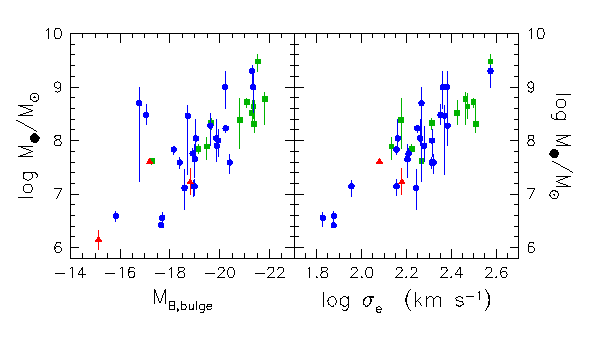
| Supermassive Black Holes in Galactic Nuclei |
|---|

Black holes with masses of a million to a few billion times the mass of the Sun are believed to be the engines that power nuclear activity in galaxies. Active nuclei range from faint, compact radio sources like that in M31 to quasars like 3C 273 that are brighter than the whole galaxy in which they live. Some nuclei fire jets of energetic particles millions of light years into space. Almost all astronomers believe that this enormous outpouring of energy comes from the death throes of stars and gas that are falling into the central black hole. This is a very successful explanation of the observations, but until recently, it was seriously incomplete: we had no direct evidence that supermassive black holes exist.
For the past twenty years, astronomers have looked for supermassive black holes by measuring rotation and random velocities of stars and gas near galactic centers. If the velocities are large enough, as in the Sombrero Galaxy, then they imply more mass than we see in stars. The most probable explanation is a black hole. About 37 have been found as of 2001 March. Their masses are in the range expected for nuclear engines, and their numbes are consistent with predictions based on the energy output of quasars.
2003 June census of supermassive black hole mass measurements (postscript) from my review paper at the Carnegie Symposium on "Coevolution of Black Holes and Galaxies"
2003 June census of supermassive black hole mass measurements (PDF)
The plot at the top of the page shows two of the main demographic results found so far:
(Left) Black hole mass correlates with the luminosity of the elliptical-galaxy-like ``bulge" part of the host galaxy. The bulge luminosity is given by the absolute magnitude in the blue ``B" band. Distances are based on a Hubble constant of Ho = 80 km/s/Mpc. Blue points are based on the motions of stars; green points are based on the motions of hot gas, and red points are based on the motions of cold gas in which water molecules emit maser radiation. The correlation says that more luminous galaxies -- that is, more massive galaxies -- contain more massive black holes. Probably, the reason is that bigger galaxies have more fuel to feed black holes.
(Right) Black hole mass versus the average line-of-sight random velocity ("velocity dispersion") of the stars in the host galaxy. These are not the stars near the center that are used to find the black holes; rather, they are the stars in the main body of the galaxy. How fast one of these stars moves is not affected appreciably by the black hole, it is determined by the other stars. If the black hole were taken away, these stars would not know the difference. Despite this, there is a tight correlation between their velocities and the black hole mass. The correlation says that more massive black holes live in galaxies whose stars move faster. How fast the stars move is determined by how much the galaxy collapsed inside its dark matter halo before stars formed. We conclude that there is a very close connection between galaxy formation and black hole fueling. Probably the major events that made the bulge and the major periods of black hole growth were the same events. Galaxy formation directly results in the black hole feeding that makes quasars shine.
To get gif or color postscript versions of the above figure, click on it. To get a more detailed discussion of supermassive black holes, click on one of the following review papers.
Review article for the general public (from Stardate magazine)
Review article for generalist scientists (from Encyclopedia of Astronomy and Astrophysics)
Perspective: Astronomy article for generalist scientists (from Science) (postscript)
Review article for professional astronomers: Kormendy and Richstone (1995) ``Inward Bound: The Search for Supermassive Black Holes in Galaxy Nuclei'' Annual Review of Astronomy and Astrophysics, 33, 581 [0.33 Mb postscript file]
University of Texas Astronomy Home Page
John Kormendy (kormendy@astro.as.utexas.edu)